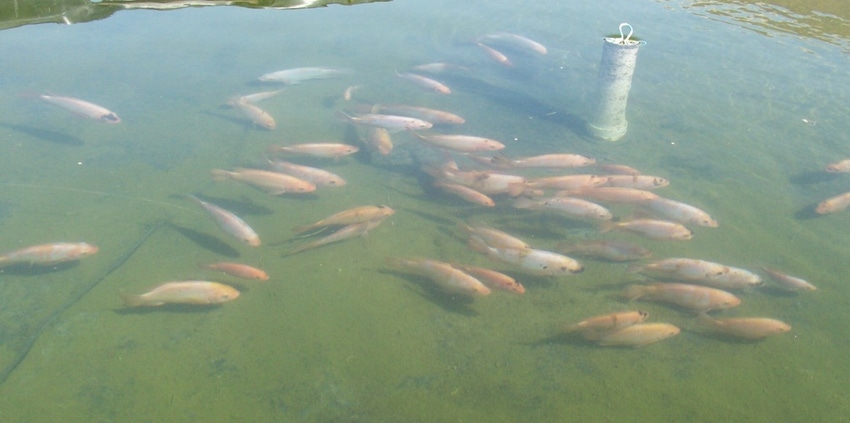
Growing fish in the Arizona desert?
Desert Springs Tilapia is an aquaculture farm located in the southwestern Arizona low desert in Dateland making great strides toward sustainable farming.A unique feature of the farm is the use of a water source which has proven inadequate for raising crops, including cotton, historically grown in this area.Farming aquatic for protein makes good sense. Aquatic animals require less energy for body support due to near neutral buoyancy.
June 26, 2013

On a hot October day, Durkee McMaster scooped up a net of quarter-sized tilapia from a round water nursery tank.
The tank is one of several at Desert Springs Tilapia, an aquaculture farm located in the central Arizona desert. With water in short supply and high demand, fish farming in this arid land may seem counterintuitive to sustainability.
On the contrary, Desert Springs is making great strides toward sustainable farming in a unique way.
The practice of aquaculture has become popular in the United States over the past 40 years, due in part to the overexploitation of global fisheries.
A 2010 United Nations Food and Agriculture Organization report said, “Never has the need for sustainable global fisheries been more apparent and never have global fish stocks been more threatened.
Want the latest agricultural news each day? Sign up for the Western Farm Press Daily free e-mail newsletter.
Kevin Fitzsimmons, professor in the Department of Soil, Water and Environmental Science at the University of Arizona, has worked in aquaculture for 25 years. He says the practice became popular in North America during the 1970s when people recognized that global fisheries were declining due to unsustainable practices, including trawling the ocean floor and overharvesting many species.
“Here in Arizona we use a lot of water for irrigation,” Fitzsimmons said. “It just made sense that we grow fish or shrimp in that water before we use it to irrigate field crops – so that all of the waste from fish goes out as fertilizer for the crops.”
McMaster and Tark Rush, former students of Fitzsimmons, co-manage and operate the Desert Springs Tilapia farm in Dateland. McMaster holds a degree in fisheries management from the UA School of Natural Resources and the Environment. Rush has a degree in microbiology.
Dealing with salty water
A unique feature of the farm is the use of a water source which has proven inadequate for raising the types of crops historically grown in the area.
This farm was originally a cotton farm, McMaster says. As groundwater was pumped down, it became salty. The salinity actually crept into the groundwater. Cotton can handle zero parts of salt so the farm was no longer able to grow cotton.”
Tilapia benefit from salinity levels of 2-4 parts per thousand, McMaster explains.
“That’s enough to kill most crops—in particular, vegetable or table crops,” McMaster said. “Fish thrive on salt water as a general rule. Even freshwater fish, to a point, will do much better with salinity in the water.”
Farming aquatic, rather than terrestrial animals, for protein makes good sense. Aquatic animals require less energy for body support due to near neutral buoyancy.
All farmed aquatic species are poikilothermic. In other words, they do not require energy to regulate body temperature. Feed conversion ratios are much higher for fish - 1.5 kilogram (kg) of feed will produce 1 kg of fish while 8 kg of feed will produce 1 kg of beef.
As a mainly herbivorous species, tilapia is a good choice to farm. The fish requires less fishmeal, oils, and protein than other aquaculture farmed species, yet still provides a great source of protein and vitamins.
The fish grown at the Arizona farm are packed fresh on ice and shipped to restaurants and supermarkets in Phoenix, Las Vegas, and Southern California.
Year-round productivity
Another unique feature of this farm is that the aquifer supplying the water is geothermally heated. The water comes out at a balmy 85- 89 degrees Fahrenheit. Tilapia thrives in water temperatures of 82-86 degrees.
This increases profitability by reducing energy costs and supports year-round production.
The farm enhances its sustainability by making a good second use of of the water. Although cotton cannot grow in the saline water, other crops can.
“Most people consider water as their primary input product, but to us, it is a waste product,” McMaster said. “You can either throw it out or you figure out ways to utilize it as a resource.”
The effluent water does not go to waste. It contains key nutrients vital to plant growth including nitrogen and phosphorus. The fish farmers are able to successfully grow acres of wheat, sorghum, alfalfa, and barley while eliminating the need for commercial fertilizers.
The efforts at Desert Springs Tilapia are helping to reduce pressure on global fisheries and provide a good source of protein to feed a growing population.
Perhaps these methods should be a more profitable and sustainable way of farming for more farmers in the future, Fitzsimmons said.
“I would like to see all agriculture in the world integrate with aquaculture and use the water twice,” Fitzsimmons said.
“Whether you are in Egypt or Pakistan or Mexico or southwestern Arizona, anybody who is pumping water to irrigate ought to grow fish in it. It doesn’t hurt anything; it just adds a lot of fertilizer value to the water, and the farmer gets another cash crop.”
Visit the Desert Springs Tilapia farm website at www.desertspringstilapia.com.
By Mary Carroll, University of Arizona student
More from Western Farm Press:
A perspective from my side of the plate
You May Also Like



